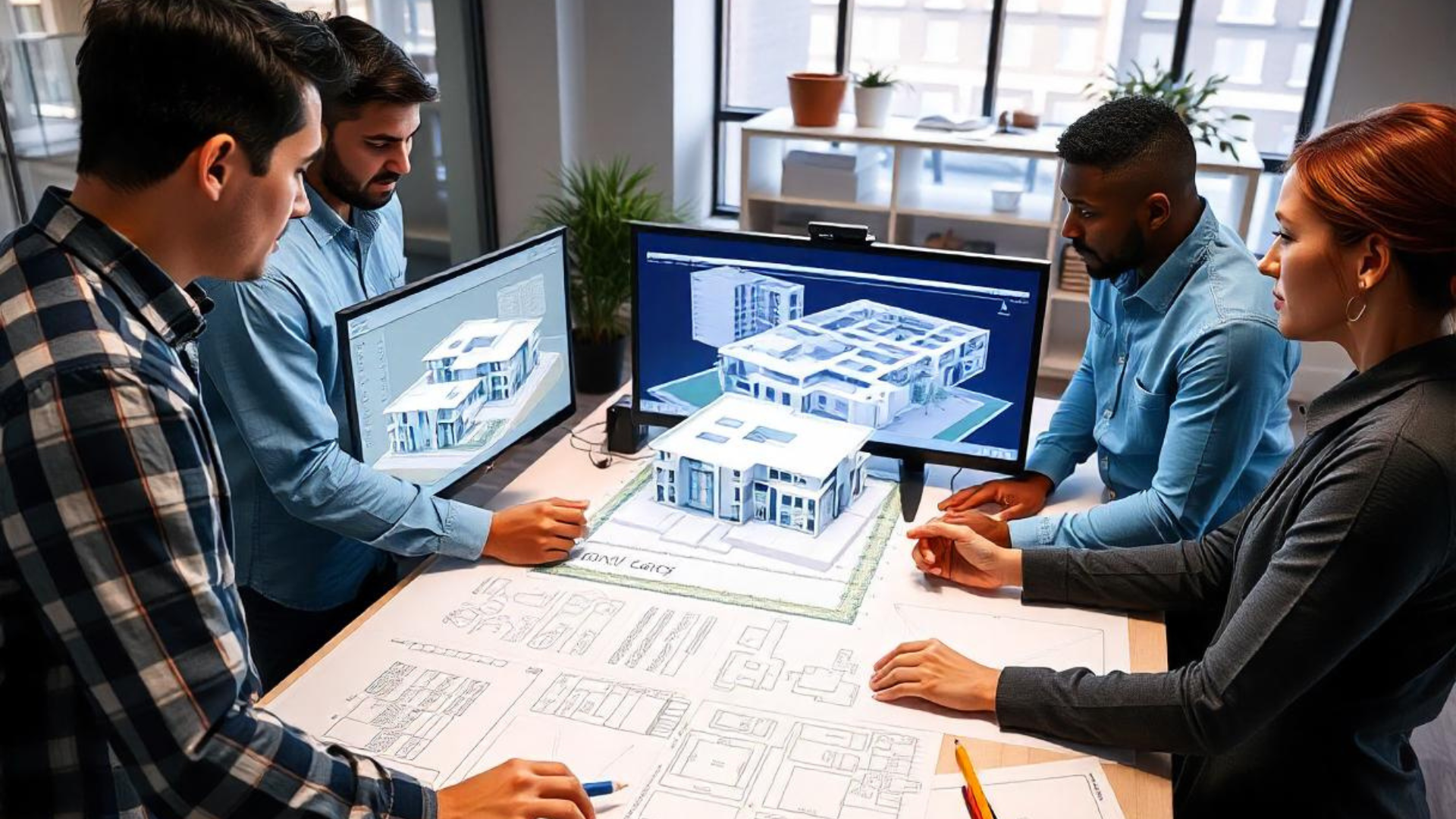
Introduction about ArchiCAD
What is ArchiCAD, and why is it important in today’s AEC industry? ArchiCAD is a leading Building Information Modeling (BIM) software developed by Graphisoft, renowned for its innovative approach to architectural design and project management. This software is essential for modern architecture, engineering, and construction (AEC) professionals, enabling them to create and manage highly detailed 3D models of buildings and infrastructure.
How does ArchiCAD shape careers in the AEC sector? By enhancing design accuracy, collaboration, and workflow efficiency, ArchiCAD empowers professionals to stay competitive and deliver high-quality projects.
Software Capabilities

What can ArchiCAD do? ArchiCAD offers a robust suite of features that cater to the unique needs of architectural design:
- 3D Visualization: Generate detailed and realistic 3D models, enhancing client presentations and project understanding.
- Teamwork Collaboration: The Teamwork feature allows multiple users to work on the same project simultaneously, facilitating real-time updates and cloud-based sharing.
- Parametric Object Libraries: Access extensive libraries of customizable parametric objects (e.g., walls, doors, and furniture) tailored to specific design requirements.
- Sustainability Analysis Tools: Tools for energy performance simulation enable architects to design buildings with lower environmental impact, aligning with sustainable development goals.
- Integrated Documentation: Automatically generate construction documents from 3D models, reducing manual drafting time and ensuring accuracy.
- Virtual Reality (VR) Integration: Create immersive virtual walkthroughs of designs, allowing clients and stakeholders to experience spaces before they are built.
Why Choose ArchiCAD?

Why should professionals or companies adopt ArchiCAD? Adopting ArchiCAD can provide numerous advantages for both individuals and organizations in the AEC sector:
- Enhanced Design Accuracy: Integrated BIM technology ensures that all project stakeholders work with the same data, minimizing errors and miscommunications.
- Efficiency and Cost-Effectiveness: Automating tasks such as clash detection and documentation generation saves valuable time, allowing professionals to focus on creative aspects of projects.
- Sustainability Integration: ArchiCAD’s sustainability tools allow architects to incorporate eco-friendly design practices, aligning with global standards for energy efficiency.
- Career Advancement: Proficiency in ArchiCAD enhances job prospects and marketability, as the demand for BIM expertise continues to rise in the industry.
- Comprehensive Support: Users have access to extensive resources, including tutorials, community forums, and official training from Graphisoft.
By embracing ArchiCAD, professionals can elevate their capabilities and contribute to innovative, sustainable architectural solutions.
Comparison with Similar Software
How does ArchiCAD compare to other software like AutoCAD and Revit? Here’s a comparison chart highlighting key features:
| Feature | ArchiCAD | AutoCAD | Revit |
| 3D Modeling | Advanced 3D capabilities | Primarily 2D with 3D add-on | Strong BIM capabilities |
| Collaboration | Teamwork for multiple users | Limited collaboration tools | Strong multi-user support |
| User Interface | Intuitive and user-friendly | Complex for beginners | Moderate learning curve |
| Sustainability Tools | Integrated analysis tools | Limited sustainability features | Built-in tools available |
| Documentation | Automated from 3D models | Manual drafting required | Automated from 3D models |
| Rendering | Quick built-in rendering | External rendering required | External rendering required |
Key Skills Gained from ArchiCAD
What skills can you develop by mastering ArchiCAD? Mastering ArchiCAD equips users with a robust skill set, both technical and transferable:
- Technical Proficiency: Advanced skills in 3D modeling, BIM management, and construction documentation.
- Collaborative Skills: Enhances teamwork capabilities, teaching professionals to coordinate effectively with various stakeholders.
- Analytical Thinking: Users learn to identify and resolve design conflicts early in the process, improving overall project outcomes.
- Project Management Skills: Develop skills in managing timelines, resources, and workflows efficiently.
- Sustainability Awareness: Knowledge of energy analysis tools fosters a strong understanding of sustainable design principles.
Career Opportunities After Learning ArchiCAD

What career paths can you pursue after mastering ArchiCAD? The opportunities are vast, with various roles available across the architecture, engineering, and construction sectors. Here are some potential positions along with their average salaries:
Average Salaries
| Career Role | Average Salary (USD) | Average Salary (India) | Average Salary (Singapore) |
| Architectural Designer | $50,000 – $80,000 | ₹500,000 – ₹1,200,000 | SGD 40,000 – SGD 80,000 |
| BIM Coordinator | $60,000 – $90,000 | ₹600,000 – ₹1,500,000 | SGD 50,000 – SGD 90,000 |
| Construction Project Manager | $70,000 – $110,000 | ₹800,000 – ₹2,000,000 | SGD 70,000 – SGD 120,000 |
| Interior Designer | $45,000 – $75,000 | ₹400,000 – ₹1,000,000 | SGD 35,000 – SGD 70,000 |
| Landscape Architect | $55,000 – $85,000 | ₹600,000 – ₹1,500,000 | SGD 45,000 – SGD 85,000 |
| Structural Engineer | $65,000 – $95,000 | ₹700,000 – ₹1,800,000 | SGD 60,000 – SGD 100,000 |
| Urban Planner | $60,000 – $90,000 | ₹500,000 – ₹1,300,000 | SGD 50,000 – SGD 90,000 |
These salaries reflect the growing demand for professionals skilled in ArchiCAD, particularly as the AEC industry continues to embrace digital transformation and sustainable practices. With proficiency in ArchiCAD, professionals can significantly enhance their career prospects in India, Singapore, and beyond.
Where Can You Learn?

Where can you find reputable courses and certifications for ArchiCAD? Consider the following options:
- Graphisoft Certified Training: Graphisoft offers official certification programs ranging from beginner to advanced levels, covering all facets of ArchiCAD.
- Online Learning Platforms: Websites such as LinkedIn Learning, Udemy, and Coursera provide flexible, self-paced courses tailored to different skill levels.
- Workshops and Seminars: Many universities and professional organizations host hands-on workshops and seminars, providing practical experience and insights from industry experts.
- Community Colleges: Various community colleges offer courses in ArchiCAD as part of their architecture and design programs, making learning accessible and affordable.
Roadmap for Learning ArchiCAD

What is the best way to master ArchiCAD? To effectively learn ArchiCAD, consider the following roadmap:
- Foundation Level (0-3 Months):
- Enroll in introductory courses on ArchiCAD basics.
- Familiarize yourself with the software interface and basic tools.
- Intermediate Level (4-6 Months):
- Take advanced courses focusing on BIM principles and collaborative features.
- Start working on small projects to apply your knowledge practically.
- Advanced Level (7-12 Months):
- Pursue specialized training in sustainability tools and advanced modeling techniques.
- Collaborate with peers on group projects to enhance teamwork skills.
- Professional Development (1 Year+):
- Obtain Graphisoft certification to validate your skills.
- Attend workshops and conferences to network and stay updated on industry trends.
How to Get a Job?

What strategies can help you secure a job in the AEC industry after learning ArchiCAD? Here are some effective job search strategies:
- Networking: Build connections with industry professionals through events, social media platforms like LinkedIn, and professional organizations.
- Online Job Portals: Utilize job search platforms such as LinkedIn, Indeed, and Glassdoor to find job listings relevant to your skills in ArchiCAD.
- Portfolio Development: Create a comprehensive portfolio showcasing your ArchiCAD projects, including design processes, challenges faced, and solutions implemented.
- Continuous Learning: Stay informed about industry trends and software updates by attending webinars, workshops, and professional development courses.
- Tailored Applications: Customize your resume and cover letter for each job application, highlighting your ArchiCAD skills and relevant experiences.
Future and Trends

What does the future hold for ArchiCAD and BIM technology? The future of ArchiCAD and BIM is promising, with several emerging trends expected to shape the industry:
- Increased AI Integration: Artificial intelligence will enhance automation, predictive analytics, and project management efficiencies in architectural design.
- Sustainability Focus: As environmental concerns grow, the demand for energy-efficient designs will rise, making ArchiCAD’s capabilities essential.
- Remote Collaboration: Advancements in cloud-based solutions will continue to facilitate remote teamwork, allowing for seamless collaboration across global teams.
- Augmented Reality (AR): The integration of AR with ArchiCAD can provide enhanced visualization tools, enabling clients to interact with designs in real-time
-
Conclusion
Why should you consider mastering ArchiCAD? Proficiency in ArchiCAD equips professionals with essential skills necessary for navigating the evolving AEC landscape. As demand for BIM expertise continues to grow, mastering this software enhances project outcomes and opens up lucrative career opportunities across various sectors. Embrace ArchiCAD to stay ahead in your career, contribute to innovative and sustainable design, and play a vital role in shaping the future of architecture and construction

